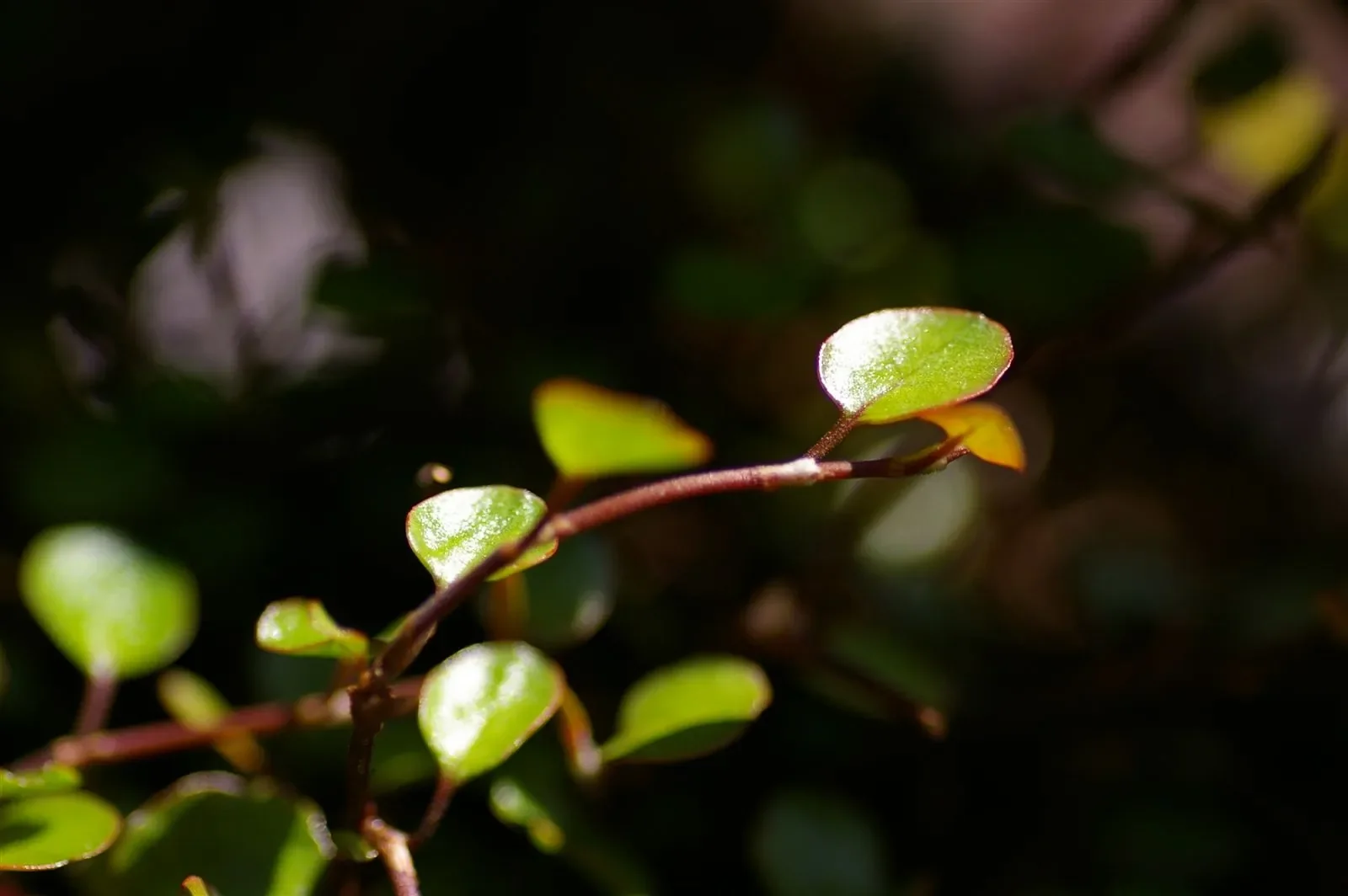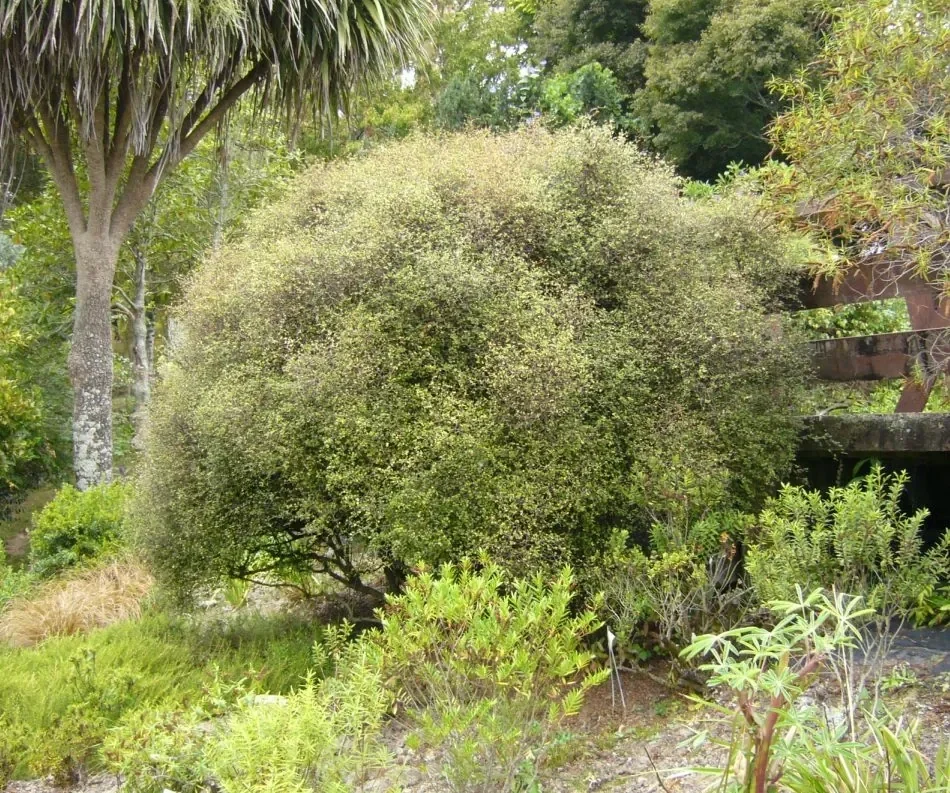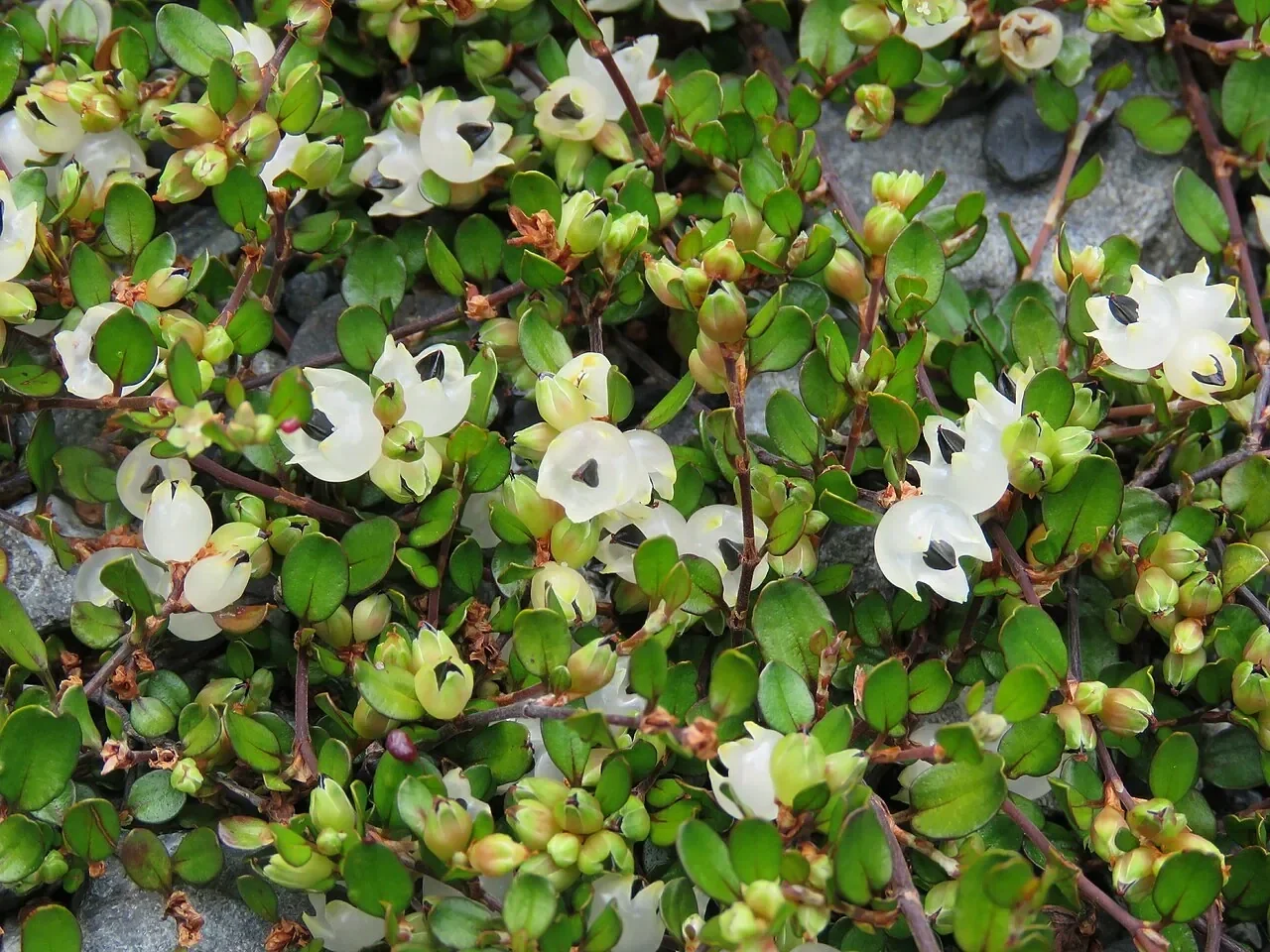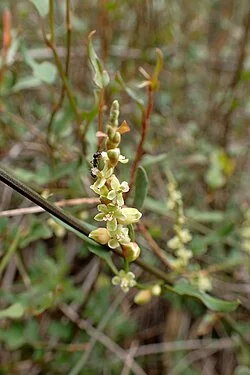
Pōhuehue
Muehlenbeckia complexa
Pōhuehue ( Muehlenbeckia complexa ), also known as Wire Vine, is a vigorous native New Zealand climber or groundcover, celebrated for its distinctive tangled, wiry stems and small, round to heart-shaped leaves. This fast-growing species is found throughout New Zealand, typically in coastal areas, forest margins, and open scrublands. Its dense, scrambling habit makes it an excellent choice for covering fences, walls, or as a tough groundcover in challenging environments. P huehue is a resilient and ecologically important plant that adds unique texture and character to any landscape, showcasing the adaptability of New Zealand's native flora. For related species, see the native plants index .

Plant Description
Botanical Features
Pōhuehue ( Muehlenbeckia complexa ), commonly known as maidenhair vine or wire vine, is a vigorous, semi-deciduous vine native to New Zealand. It forms a dense, thick mass of interlaced, wiry, reddish-brown stems with small, rounded, emerald-green leaves. The leaves are petiolate, variable in shape and size, and can have lobed or entire margins. It can grow as a climber, reaching up to 5 meters, or as a groundcover. The plant produces small, delightfully scented, greenish-white flowers in late spring to mid-summer. It is dioecious, meaning individual plants are either male or female, so both sexes are needed for seed production. Female plants develop small, white berries with black seeds that attract birds and lizards.
Quick Facts
| Scientific Name | Muehlenbeckia Complexa |
|---|---|
| Common Name | Pōhuehue, Wire Vine, Small-leaved Pōhuehue |
| Family | Polygonaceae |
| Height | Climbing up to 4 m, or spreading groundcover |
| Spread | Spreading, up to several meters wide |
| Light | Full sun to partial shade |
| Soil | Well-drained, adaptable to most soil types |
| Water Needs | Low to Moderate |
| Frost Tolerance | High |
| Salt Tolerance | High |
| Growth Rate | Fast |
| Lifespan | Perennial |
Climate Best Suited to
Pōhuehue ( Muehlenbeckia complexa ) is widely distributed throughout New Zealand, from coastal to montane areas, indicating its broad adaptability to various climates. It thrives in mild, temperate climates but is remarkably tolerant of a wide range of conditions, including strong winds, salt spray, and moderate frosts. Its natural habitat includes coastal cliffs, sand dunes, forest margins, and open scrublands. It can be successfully cultivated in most temperate regions, provided it has good drainage and protection from extreme, prolonged droughts or severe, sustained frosts when young.
Regional Suitability
| City | Climate Suitability |
|---|---|
| Whangārei | Ideal |
| Auckland | Ideal |
| Hamilton | Ideal |
| Tauranga | Ideal |
| Rotorua | Ideal |
| Gisborne | Ideal |
| New Plymouth | Ideal |
| Napier | Ideal |
| Whanganui | Ideal |
| Palmerston North | Ideal |
| Wellington | Ideal |
| Nelson | Ideal |
| Christchurch | Ideal |
| Dunedin | Ideal |
| Invercargill | Ideal |
Natural Habitat
Typical Environments
Understand the natural habitat of Pōhuehue ( Muehlenbeckia complexa ), which is found throughout New Zealand, in coastal areas, forest margins, and open scrublands. This section details its geographical distribution, preferred environmental conditions, and the types of ecosystems where it naturally occurs.
- Widespread across New Zealand, from sea level to moderate altitudes.
- Found on coastal cliffs, sand dunes, forest margins, and open scrublands.
- Prefers well-drained sites with good air circulation.
- Thrives in full sun to partial shade.
Its broad habitat range highlights its adaptability and resilience, making it a fascinating subject for ecological study.
Plant Conservation
Muehlenbeckia complexa , also known as p huehue or wire vine, is a plant native to New Zealand, Australia, and the Solomon Islands.
In New Zealand, the NZPCN classifies the conservation status of Muehlenbeckia complexa var. complexa as "Help," suggesting that it may require monitoring or local conservation efforts. It is not listed as a threatened species on the IUCN Red List.
However, in some regions, such as the Golden Gate National Recreation Area in San Francisco, it is considered a problematic invasive species.
Growing Requirements
Soil Requirements
Pōhuehue is highly adaptable to a wide range of soil types, but it thrives best in well-drained soils. It can tolerate sandy, loamy, and even some clay soils, provided there is good drainage. Incorporating organic matter can improve soil structure and moisture retention. A neutral to slightly acidic pH is generally preferred.
- Adaptable to most well-drained soil types.
- Prefers fertile soils with good drainage.
- Tolerates sandy, loamy, and some clay soils.
- Neutral to slightly acidic pH preferred.
Light Requirements
Pōhuehue performs well in full sun to partial shade. In full sun, it tends to be denser and more compact, producing more flowers and berries. In partial shade, it may grow a bit more sprawling but will still thrive. Ensure it receives adequate light for healthy growth and development.
- Full sun to partial shade.
- Denser growth and more flowers/berries in full sun.
- Adaptable to various light conditions.
Water Requirements
Pōhuehue requires low to moderate watering, especially during dry periods and its establishment phase. Once established, it is reasonably drought-tolerant and requires minimal supplemental watering. Ensure the soil is consistently moist but not waterlogged.
- Low to moderate watering needs.
- Drought-tolerant once established.
- Avoid waterlogging.
Planting Guide
Best Time to Plant
The best time to plant Pōhuehue is during autumn or spring, when temperatures are mild and rainfall is more consistent. This allows the plant to establish its root system before the extremes of summer heat or winter cold.
Choosing a Location
Select a site with full sun to partial shade and well-drained soil. Pōhuehue is highly adaptable and can be planted in coastal areas, exposed sites, or more sheltered garden beds. Ensure it has adequate space for its vigorous growth habit.
Planting Steps
- Dig a hole twice the width of the root ball and the same depth.
- Gently remove the plant from its container, being careful not to disturb the roots.
- Place the plant in the hole, ensuring the top of the root ball is level with the surrounding soil.
- Backfill with amended soil, firming gently around the base of the plant.
- Water thoroughly immediately after planting to settle the soil.
- Apply a layer of organic mulch to help retain moisture and suppress weeds, keeping it away from the stem.
Initial Care
Water regularly during the first 6-12 months to help establish a strong root system. Once established, Pōhuehue is reasonably low maintenance and requires less frequent watering. Protect young plants from strong winds and severe frosts if necessary.
Ecological Role
Ecosystem Roles
The ecological importance of Pōhuehue ( Muehlenbeckia complexa ) within its native New Zealand ecosystems is significant. Its dense, tangled growth provides shelter for small birds and invertebrates, and its berries are a food source for native birds, contributing to the local food web and aiding in seed dispersal across diverse habitats.
- Provides shelter for small birds and invertebrates.
- Berries are a food source for native birds.
- Contributes to biodiversity in diverse ecosystems.
As an endemic species, it is an integral part of the unique biodiversity that has evolved in New Zealand, supporting the delicate balance of its natural habitats.
Uses and Significance
Garden Uses
- Excellent groundcover for banks, slopes, and difficult areas.
- Suitable for covering fences, walls, and pergolas as a climber.
- Provides year-round interest with evergreen, wiry stems and small leaves.
- Attracts native birds to its berries.
Landscaping Applications
Pōhuehue ( Muehlenbeckia complexa ) is a highly versatile and attractive plant for various landscaping applications, particularly in native and low-maintenance gardens. Its vigorous growth and unique texture make it a valuable asset.
- Ideal as a groundcover for banks, slopes, and difficult areas.
- Excellent for covering fences, walls, and pergolas as a climber.
- Provides year-round interest with evergreen, wiry stems and small leaves.
- Suitable for mass plantings or as an accent plant.
Its ability to thrive in challenging conditions and its aesthetic appeal make it a popular choice for creating resilient and beautiful native landscapes.
Seasonal Care Calendar
Spring
New growth emerges, and tiny, inconspicuous flowers may appear. This is an ideal time for planting new Pōhuehue specimens or propagating from cuttings. Ensure consistent moisture for young plants and protect them from strong winds if necessary. A light feed with a balanced slow-release fertilizer can encourage vigorous growth.
- Ideal time for planting and propagation.
- Ensure consistent moisture for new plants.
- Light fertilization if needed.
Summer
Pōhuehue is actively growing and flowering during summer, followed by the development of berries. Consistent watering is important, especially during dry spells, to prevent stress. Monitor for pests and diseases, though it is generally quite resilient.
- Active growth and flowering.
- Consistent watering is essential.
- Monitor for pests and diseases.
Autumn
Berries ripen and become prominent in autumn, providing a valuable food source for native birds. This is another good time for planting, allowing roots to establish before winter. Minimal care is required for established plants, but ensure they remain adequately hydrated.
- Berries ripen, attracting birds.
- Good time for planting.
- Minimal care for established plants.
- Ensure adequate hydration.
Winter
Pōhuehue is evergreen and provides year-round interest. It is highly frost-tolerant and requires minimal care during this period. Ensure good drainage to prevent root issues in wet conditions.
- Evergreen, provides year-round interest.
- Protect young plants from severe frost.
- Ensure good drainage.
When to Prune and How Much
Pōhuehue is very amenable to pruning and can be shaped as a groundcover, climber, or even a low hedge. Regular pruning helps maintain its desired size and form, and encourages denser growth.
- Light trimming can be done at any time of year to maintain shape.
- For hedging, prune after the main flush of new growth in spring/early summer.
- Heavy pruning to reduce size or rejuvenate can be done in late winter/early spring.
- Remove dead, damaged, or diseased stems as needed.
- Use clean, sharp tools.
Pōhuehue responds well to even hard pruning, making it a very forgiving plant for shaping and maintenance.
How to Grow Pōhuehue
Pōhuehue, also known as Wire Vine, is a vigorous native New Zealand climber or groundcover, celebrated for its distinctive tangled, wiry stems and small, round to heart-shaped leaves. This fast-growing species is found throughout New Zealand, typically in coastal areas, forest margins, and open scrublands. Its dense, scrambling habit makes it an excellent choice for covering fences, walls, or as a tough groundcover in challenging environments. P huehue is a resilient and ecologically important plant that adds unique texture and character to any landscape, showcasing the adaptability of New Zealand's native flora. Understanding its propagation methods is key to successfully growing this versatile species.
From Seed
Propagating Pōhuehue from fresh seed is a viable method, though germination can be slow and may require stratification. Collect ripe seeds in late autumn or early winter. Clean the seeds thoroughly to remove any fleshy pulp. Sow the seeds in a tray filled with a well-draining seed-raising mix, lightly covering them. The seeds typically require a period of cold stratification (e.g., refrigerate for 2-3 months) to break dormancy. Maintain consistent moisture in the seed tray and keep it in a warm, sheltered location. Germination can take several weeks to months after stratification. Once seedlings have developed a few true leaves, they can be potted into individual containers and grown in a sheltered environment before planting out.
From Cuttings
Semi-hardwood cuttings are the most reliable and efficient method for propagating P huehue, ensuring that new plants retain the exact characteristics of the parent. Take 10-15 cm cuttings from healthy, semi-hardwood stems in late summer or early autumn. Remove the lower leaves and dip the cut end in a rooting hormone. Insert the cuttings into a well-draining propagation mix (e.g., sand and perlite). Keep the cuttings in a warm, humid environment, out of direct sunlight, perhaps under a plastic dome or in a propagator. Rooting typically occurs within 8-12 weeks. Once rooted, the new plants can be potted on and grown in a sheltered environment until they are ready for planting.
Pests and Diseases
Pōhuehue is generally a robust plant, but it can be susceptible to certain pests and diseases, especially if not grown in optimal conditions.
Common Pests
- Aphids: Can infest new growth. Treat with insecticidal soap or remove manually.
- Scale Insects: May be present on stems and leaves. Treat with horticultural oil or appropriate insecticides.
Common Diseases
- Sooty Mould: Often associated with scale insect infestations, it can cover leaves and reduce photosynthesis. Address the underlying pest issue.
- Root Rot: Caused by overwatering or poor drainage. Ensure well-drained soil.
Good garden hygiene, proper watering, and adequate air circulation are key to preventing most pest and disease issues. Regular inspection will help catch problems early.
Cultural Significance
Muehlenbeckia complexa , also known as p huehue in Māori, holds cultural significance primarily in its native New Zealand.
Key Aspects of Its Cultural Significance Include:
- Traditional Māori Use: The succulent flowers of Muehlenbeckia complexa were consumed by Māori, particularly children, who enjoyed their sweet and juicy taste.
- Ecological Importance: In its natural habitat, the plant plays a crucial role in ecological restoration and maintenance. It helps to stabilize disturbed ground, such as forest edges and sand dunes, and aids in suppressing the growth of invasive weeds like blackberry. This contributes to the health and resilience of native ecosystems.
- Biodiversity Support: Muehlenbeckia complexa is a vital host plant for several endemic insect species, including various copper butterflies. It also provides a food source (buds, leaves, and edible fruits) for native birds such as tūī, bellbird, and kererū, as well as geckos. Its dense growth offers shelter for insects and nesting sites for birds.
- Horticultural Applications: Beyond its native environment, Muehlenbeckia complexa has been cultivated for its ornamental value. It has been used in horticulture for covering banks, walls, and structures, for topiary, and as an attractive plant for hanging baskets due to its fast growth and ability to create a soft, tangled effect.
Bonus Tip
Expert Growing Advice
The tangled, wiry stems of Pōhuehue are not just for show. In its natural habitat, it plays an important role in sealing forest edges after disturbances, preventing the spread of introduced weeds and providing a nursery for other native plants to establish. It is also a host plant for several species of native copper butterflies.







